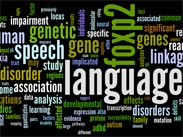
Are we entering the golden age of neuroscience? Will this decade represent the dawn of a new era that will revolutionize our understanding of how the human mind and brain work? While significant advancements in the field have been made over the past five to ten years, much work still remains for understanding our neural architecture – the networks of brain cells that facilitate our thoughts, perceptions, and behaviors. “As humans,” President Obama stated last year, “we can identify galaxies light years away, we can study particles smaller than an atom, but we still haven’t unlocked the mystery of the three pounds of matter between our ears.”
Our understanding of the complex neural mechanisms underlying speech and language development, for example, is still fairly limited. With brain, language, and speech disorders affecting millions globally, acquiring a better understanding of the human mind is imperative. In April 2013, the Obama administration launched its Brain Research through Advancing Innovative Neurotechnologies (BRAIN) Initiative, which seeks to “uncover new ways to treat, prevent, and cure brain disorders like Alzheimer’s, schizophrenia, autism, epilepsy, and traumatic brain injury.”
This recent push to accelerate the pace and success of brain research worldwide is illustrated by other large-scale initiatives, such as Neurodata Without Borders(NWB) and the Human Brain Project (HBP). NWB, an initiative launched by prominent U.S. research institutions, aims to standardize neuroscience data on a global scale; the HBP, on the other hand, is a collaborative European research effort bringing together hundreds of scientists from 112 institutions in 24 countries and 12 research areas.
From September 29 to October 1, 2014, the Human Brain Project will convene at Heidelberg University in Germany for the HBP’s first annual summit. More than 360 participants spanning the globe from Austria to Israel will present their research findings in neuroscience, medicine, and computing as well as discuss the key challenges facing international collaborative brain research in the future. Heidelberg physicist Prof. Dr. Karlheinz Meier, a member of the HBP Board of Directors and co-leader of the Neuromorphic Computing sub-project, will direct this year’s summit.
__________________________________________________________________________________________